Sunapati Thangka School
What’s Brian Blessed most valuable possession?
The English actor Brian Blessed recently released an interview to the Daily Mail
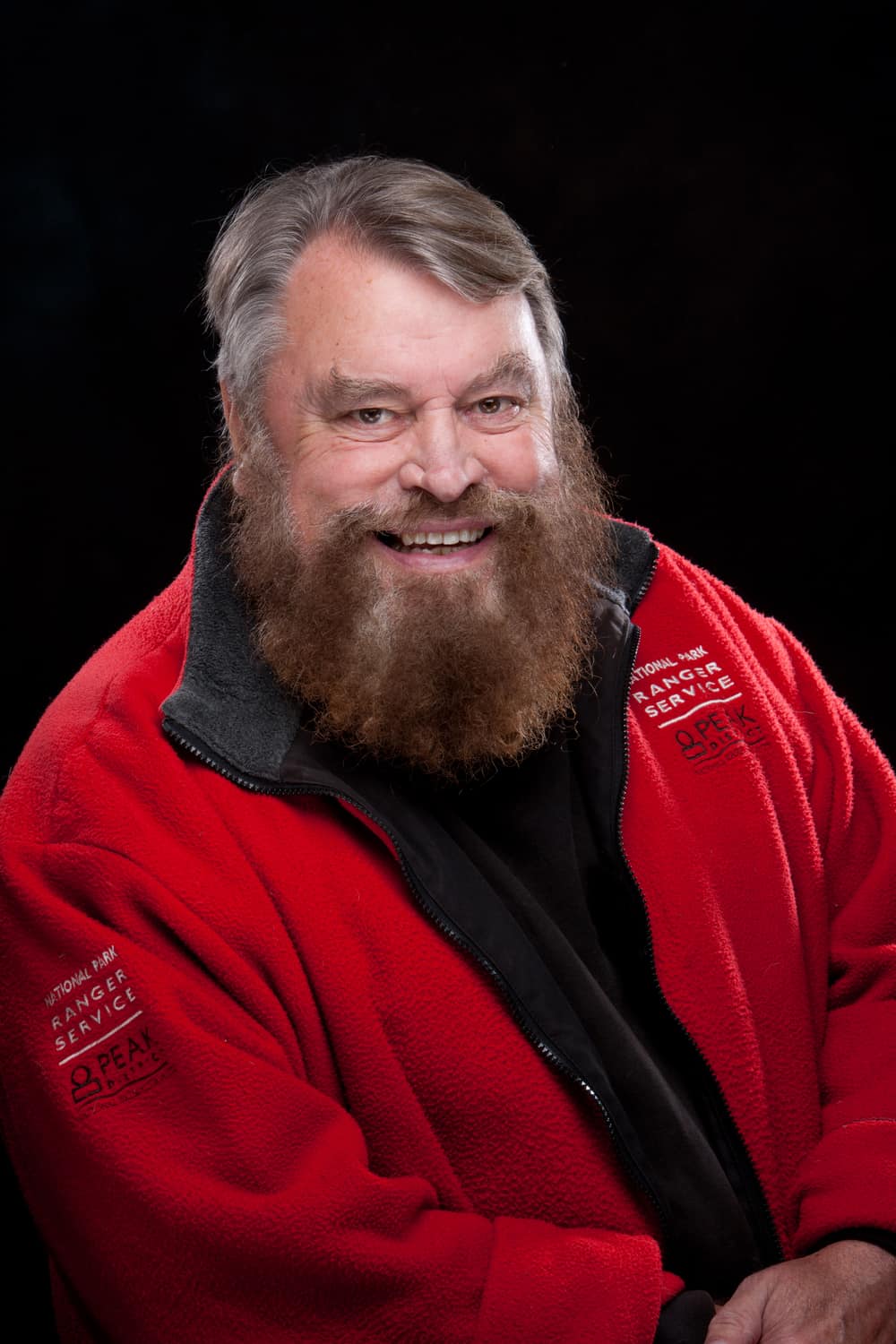 where he was asked what is the prized possession he values above all other.
where he was asked what is the prized possession he values above all other.
Mr. Blessed answered: “An ancient Tibetan Thangka given to me by the Dalai Lama in 1990 before my ascent of Everest.”
Tattoo Artists on Tibetan Thangka Art
It is always rewarding for us to read western artists opinions about the traditional art of thangka paintings.
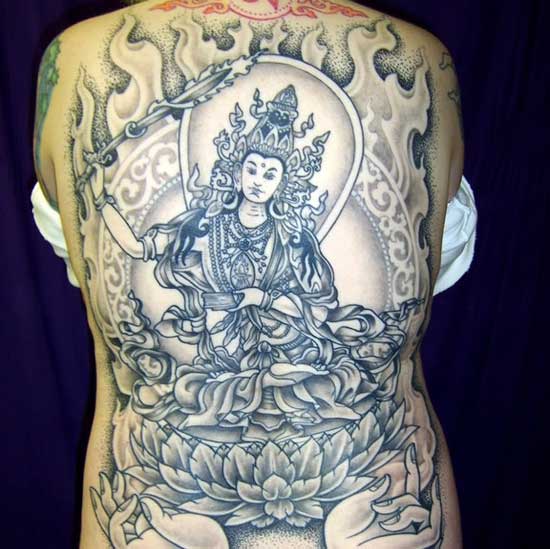
Thangka Inspired Tattoo
Especially if the artists comes from a background that have such a strong appeal on younger generations as Tattoo art.
Here an interesting article written by Heidi Minx posted on shambhalasun.com
Top tattoo artists talk Tibetan thangka art with Heidi Minx
Having studied art and dharma, and being tattooed for over two decades, my interests collided when I worked on the “Tattoos of Tibetan refugees and ex-political prisoners” project in India last year. Much of the pieces I saw were simple, hand-poked ones that frequently incorporated Bon and Tibetan symbols such as the yundon and dorjee. Here in the West, it’s common for us to see more elaborate, full-color pieces inspired by Buddhas and dharma images by very talented artists from across the ages.
In 2009, I briefly studied the process of thangka with a master in Dharamsala. The training process (a minimum of a five-year full-time commitment), as well as the discipline required, reminded me of the time-honored tradition of tattoo apprenticeships. For example, thangka students must learn the grids and proportional measurements for the three body types: male Buddhas, female Buddhas, and wrathful deities. They must first learn to draw perfectly, often drawing consistently for three years before they are even allowed to touch the paints. They must hand-grind the paints and make canvasses for the senior students — all of this reminded me of tattoo artists learning to clean shop stations properly, drawing, learning how to make needles by hand.
I’ve also learned that tattoo artists themselves often have deep admiration for this style of art, themselves. Here, three big names tell us why in their own words. (Click their names for more information about these artists and to see more of their phenomenal work.)
“I’ve been attracted to Tibetan art for a long time. In 93, I traveled through Northern India, Nepal, and Tibet, and purchased quite a few thangkas. They are beautiful and tell such elaborate stories and I know what I feel when I look at them: They seem to be a call to the primal love of god, even if they are not specific to your religion. The details, imagery, layouts — I love them. The fact that the wrathful deities are meant to protect us, it makes perfect sense to me that they be transposed to skin.
“I have tattooed a lot of the imagery over the past 20 years. The contrasting colors and the lines allow them to translate onto the skin so easily. I don’t think in general people are aware of how skilled a painter must be to create these. We can easily find the value of work by, say, Andy Warhol. Several years ago I went to have one of mine appraised. It was a 300-year-old thangka, the appraiser simply told me he didn’t know; it was worth whatever someone would pay for it.”
“Personally, I’ve always been attracted to thangka for the dynamic life/death struggle represented as well as the anthropomoprhic representations of the deities. Thangkhas contain all the elements of mystery that, when I was a young man, fascinated me about the East: strange “alien” text, hallucinogenic geometric designs, shamanistic sacrifice, otherworldly structures. It’s one art form that really has it all.”
“The process of thangka painting seems to parallel tattoo art like no other art-form. Like tattooing, the process is thousands of years old. If done correctly, the paint is hand-mixed with mineral pigments. Artists make their own canvas using natural glues and distemper on 100% cotton. The studying is intense — a minimum of five years. You must draw perfectly first, for 3 years, before you ever touch paint. Your lines must be delicate. You learn to shade with the mineral pigments, and lines must be precise and delicate. The best brushes from Japan are preferred. When it is done correctly, it is fine art.
“That reminds me of tattoos — another ancient art, originally passed on from master to student. The apprentice tattooist learns to make needles, mix colors, cut stencils and draw. The traditional tattoo apprentice must learn to pay close attention to detail and do what his teacher asks him to do. Eventually, the apprentice progresses to tattooing, maybe himself at first. Like thank painting there is a sense of discipline and respect for tradition that, when learned properly, will shine through in the work.
“These are images that tell stories, and aren’t just painted to be pretty artistic expression (although they usually are). Most importantly, they, like the best art, have the power to teach the viewer things about life.”
Shoton Festival- Exhibition of Thangkas and Tibetan Masks in Lhasa
The Shoton Festival is held each summer in Lhasa and it is considered to be the largest Tibetan festival. Also known as the Yogurt Banquet festival it dates back to the 11th century and was originally a religious occasion, when local people would offer yogurt to monks who had finished their meditation retreats.
It is a very appealing event not only for Tibetans and Buddhists coming from different countries, but also for many travelers willing to discover this striking event on the roof of the world.
The festival mainly consists in exhibitions showing the art, tradition and the appealing culture of the Tibetan people. Very famous events are the Tibetan Opera Show and the Horsemanship and Yak Race Show. However the main event that open the festival is the display of the giant thangka showing the Great Buddha.
During the ritual more than 100 monks unveil an old 1,480 square-meter portrait of Sakyamuni knitted with colorful silk.
During the festival (this year from the 6th to the 12th of August) there are celebrations in the streets, squares and monasteries of Lhasa.
As part of this year’s festival, a grand exhibition of traditional Thangkas and Tibetan masks is staged at Norbu Lingka, the former summer palace of the Dalai Lamas.
Mandala: Sacred Geometry and Healing Art
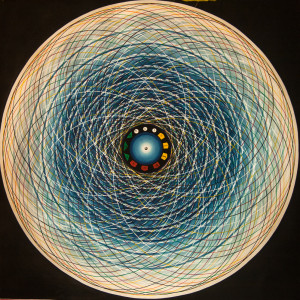 The word mandala is of Hindu origin and is derived from the root ‘manda’, which means essence, and the suffix ‘la’, meaning container.
The word mandala is of Hindu origin and is derived from the root ‘manda’, which means essence, and the suffix ‘la’, meaning container.
Mandala is a term that appears on a chapter of the Rig Veda, a collection of mantras or hymns chanted in Vedic ceremonies. The universe was believed to originate from these mantras, whose sacred sounds contained the genetic patterns of beings and things. This is the reason why it is possible to define “mandala” as a world-model.
In fact mandalas usually represent sacred places which, by their very presence in the world, remind a viewer of the immanence of sanctity in the universe and its potential in his or her self.
Generally speaking mandala is a term for any geometric symbol that represents the cosmic energy in a metaphysical or symbolic matter.
Mandala Buddhist Art
Among the many traditions of Buddhist art the three areas where the Tibetans have made the most significant contributions are mandalas, images of deities and portraiture. In the context of the Buddhist path the purpose of a mandala is to put an end to human suffering, to attain enlightenment and a correct view of reality. It is a mean to discover divinity by the realization that it resides within our own self.
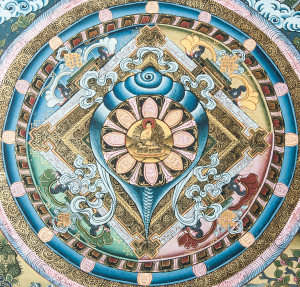 In Tibetan Buddhism mandalas are used for meditation and their specific designs reminding the practitioner of important guiding principle.
In Tibetan Buddhism mandalas are used for meditation and their specific designs reminding the practitioner of important guiding principle.
In fact it is used as visual aid for concentration and meditation leading to the attainment of insights and to activation of forces culminating in “Siddhi”, term used by tantric buddhism doctrine to define special psychic powers.
In its most common form, the mandala appears as a series of concentric circles. Each mandala has its own resident deity housed in the square structure situated concentrically within these circles. Its perfect square shape indicates that the absolute space of wisdom is without aberration. This square structure has four elaborate gates. These four doors symbolize the bringing together of the four boundless thoughts namely – loving kindness, compassion, sympathy, and equanimity. Each of these gateways is adorned with bells, garlands and other decorative items.
This square form defines the architecture of the mandala described as a four-sided palace or temple.
A palace because it is the residence of the presiding deity of the mandala, a temple because it contains the essence of the Buddha.
Mandala Healing Art
Painting mandalas isn’t an activity done merely in religious contexts.
It’s an art for everybody. And it’s a very effective Therapeutic Art !
Carl Gustav Jung introduced the Eastern concept of the mandala to Western thought and believed this symbol is a representation of the individuality and a reflection of the Self.
According to Jung, mandalas symbolize “a safe refuge of inner reconciliation and wholeness.”
The creative process of making mandalas helps to revisit the universal experience embodied in the circle and, as Jung found, helps us to experience and reflect on the essence of who we are in the here and now.
Not only are Mandalas very healing to paint but they radiate healing energy.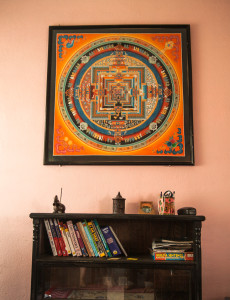
In fact when you have such a mandala in your house, its presence creates a powerful field of energy.
That is why we suggest our customers to place their mandala in a room where they spend five or more hours each day.
This could be your bedroom, your office or your living room.
If you are travelling in Nepal and you are willing to learn how to paint beautiful thangka and mandala paintings feel free to send us a message or contact us using your favorite social media:
Facebook
Twitter
Instagram
Sunapati Thanka Painting School
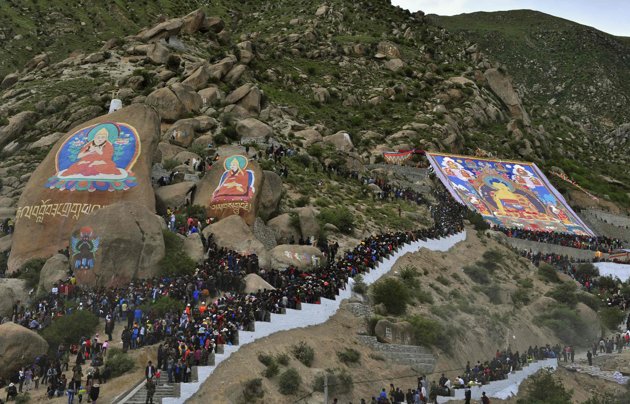
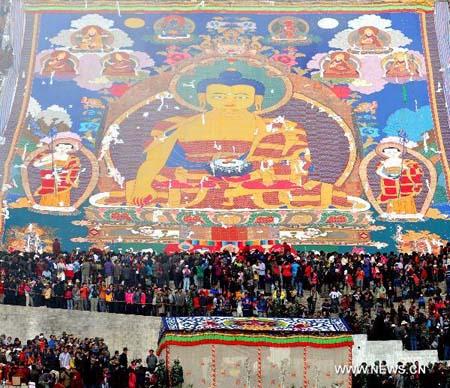
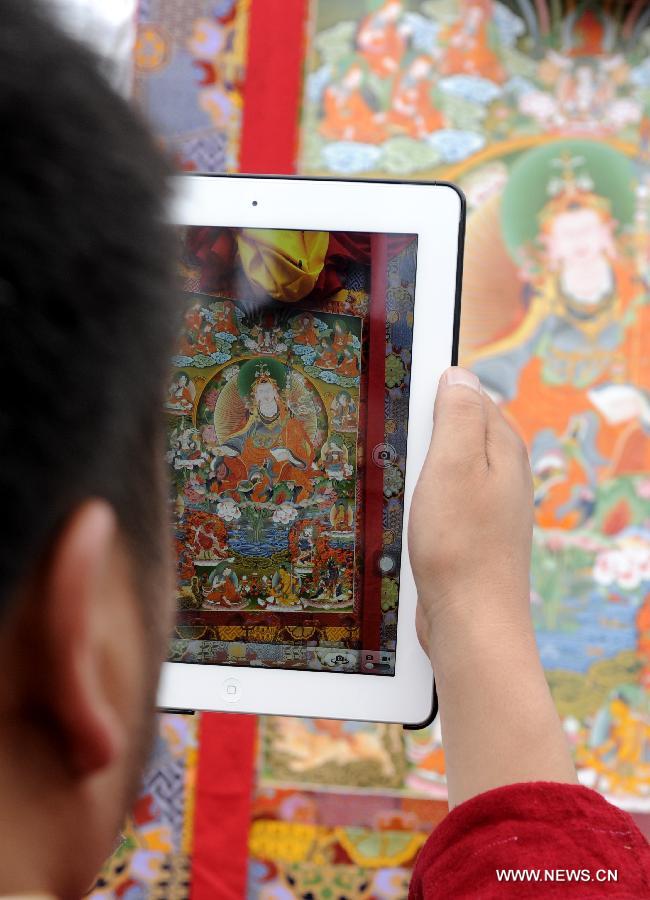
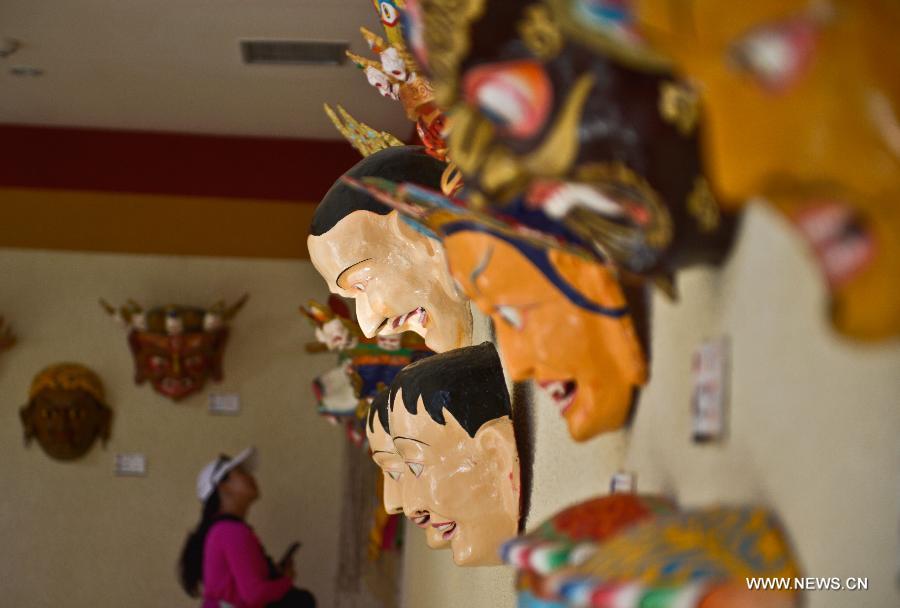
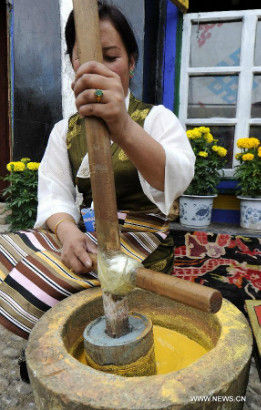
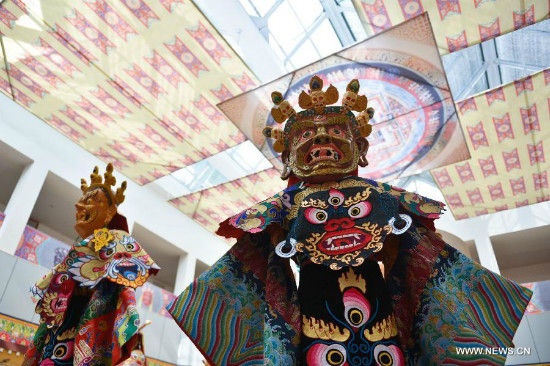
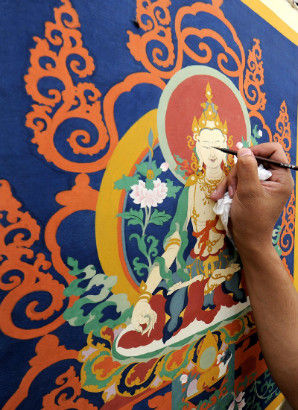
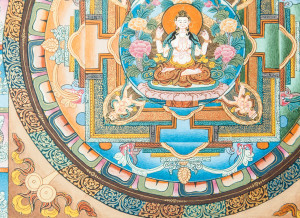
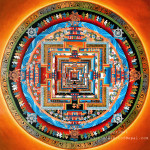 Kalachakra Mandala
Kalachakra Mandala 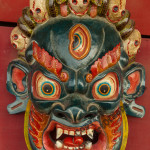 Wrathful Bhairava Mask
Wrathful Bhairava Mask 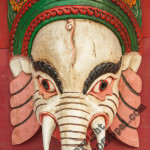 Ganesh Mask Design #02
Ganesh Mask Design #02 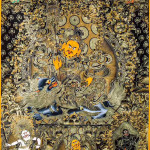 Five Jambhala Thangka
Five Jambhala Thangka 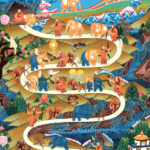 Samatha Meditation Thangka
Samatha Meditation Thangka 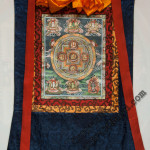 Silk Frame #02
Silk Frame #02 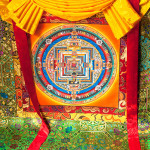 Modern Design Brocades
Modern Design Brocades 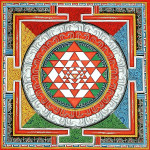 Sri Yantra Mandala
Sri Yantra Mandala 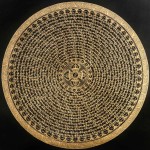 Yin Yang Mantra Mandala
Yin Yang Mantra Mandala 





